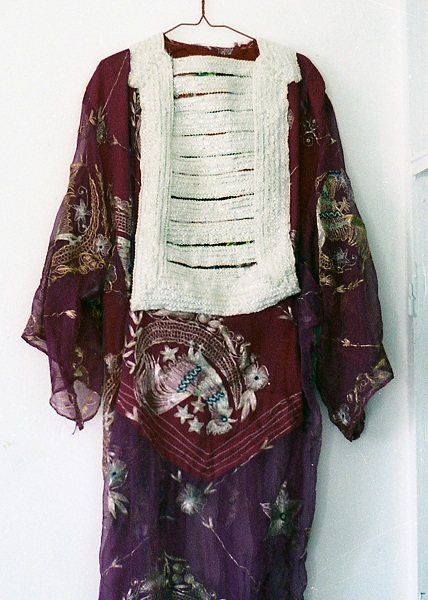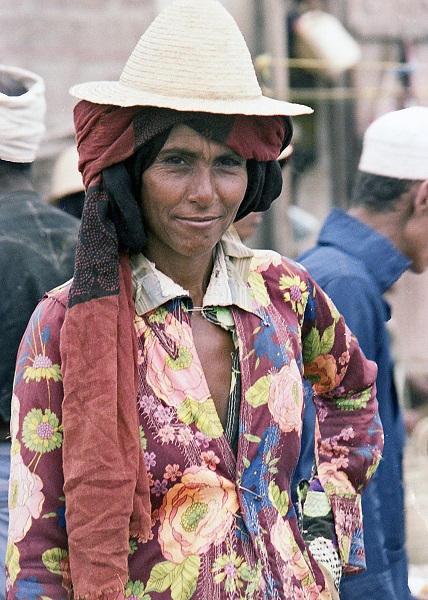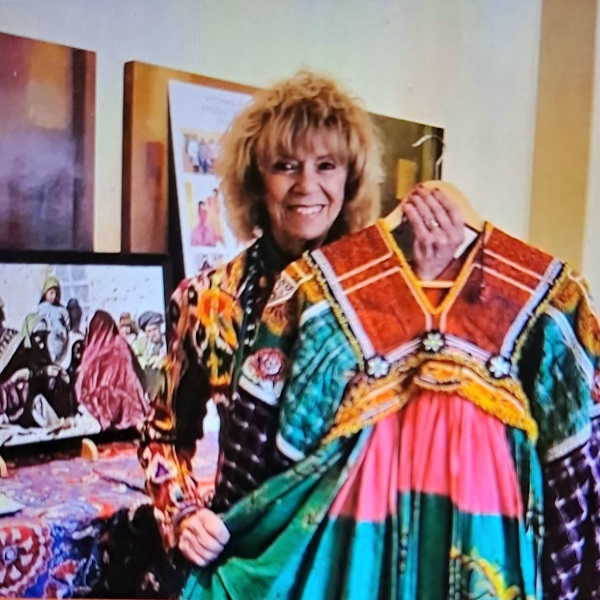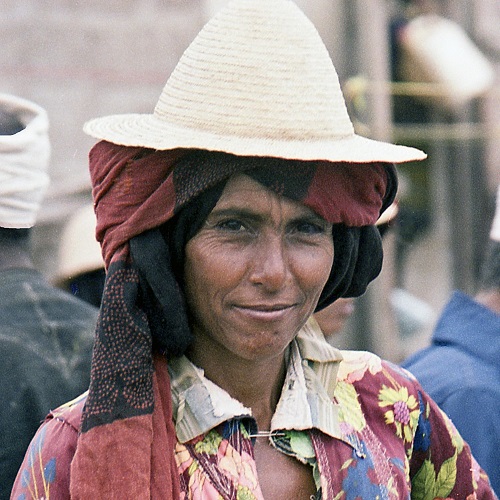This is the sixth post in a series on Yemeni dress, customs, and craft written by guest contributor Darleen Wilkerson Karpowicz, an American art teacher who lived in Yemen for five years in the early 1980s. During this time Darleen documented and studied the costume, customs, and crafts of the people she learned to love.
 A woman from Zabid wearing a typical traditional dress
A woman from Zabid wearing a typical traditional dressTihamah – Yemen’s coastal plains
Many things change as Taiz, Jebel Sabir, and Jebal Habashi are left behind and the descent is made through the foothills of Hagda onto the Tihamah. Not only in the character of the dwellings and the features of the people but also in the dramatic change in the style of the women’s dresses.
During my visit, much of this coastal plain was devoid of any agriculture and the rural dwellings were in small clusters of round African style huts with thatched roofs and mud or dead acacia thorn enclosed compounds. People of the Tihamah were noticeably poorer and lived in a much harsher environment than the people of the central and southern uplands. Agriculture was dominated by irregular rainfall, with limited production to the wadi beds and irrigated areas fed by subterranean water pumped from wells and boreholes. Only in these situations did agricultural production flourish.
 An example of a typical traditional Zabid dress
An example of a typical traditional Zabid dressTihamah Dresses
The villages here were not as isolated from each other as those located on the tops of high mountains and yet a tremendous regional variety of garment styles existed. Zabid and
Bayt
Bayt: (Arabic: house). Colloquially in the UAE it refers to the larger, middle part of the decorative ankle-cuff (bādlah) and can include between one to twenty different braids (talli
Tallī: (Turkish: tel – wire, string), Gulf Arab – a woven braided trimming made with metal wire, threads and ribbons often sewn on detachable panels used as embellishments. Other – (Synonym: tulle_bi_talli
Tūlle_bi_tallī: (French: Tulle – a city in France where fine material for veil was first made; Turkish: tel – wire; Synonym: tariq; talli; badla; khus_dozi
Khus_dozi: (Persian: Khvosh – an Iranian province; dozi – needlework; Synonym: tariq; talli; tulle_bi_talli; badla), series of small metal knots made on a woven net ground as embellishment. The term is commonly used in Iran and parts of the Arabian Peninsula possibly because Khvosh was one of the centres for the craft.
), series of small metal knots made on a woven net ground as embellishment. The term is commonly used in the North African Arab region specifically in Egypt.
; tariq; badla; khus_dozi
Khus_dozi: (Persian: Khvosh – an Iranian province; dozi – needlework; Synonym: tariq; talli; tulle_bi_talli; badla), series of small metal knots made on a woven net ground as embellishment. The term is commonly used in Iran and parts of the Arabian Peninsula possibly because Khvosh was one of the centres for the craft.
), series of small metal knots made on a woven net ground as embellishment.
_fatlah
Fātlah: (Arabic: fatala: to twist/twine, pl. fātlāt/ftūl), in the UAE colloquially, it refers to braids in (tallī) work. The braid or strand resembles a running stitch, where the effect is attained by continuously looping metallic thread with silk, cotton, or synthetic thread. ), hand-stitched side by side in different motifs, and hemmed by a few lines forming the rim (trāf). al Faqih were the largest towns on the Tihamah, some thirty miles apart with no settlements of any size located between them. Despite their proximity, their dresses were very different.
The Tihamah dresses are easily classified into regional types, but the distribution of the types is more fluid and less well-defined than those found in the mountain areas. That is to say that a dress may have been recognised as worn in the region of
Bayt
Bayt: (Arabic: house). Colloquially in the UAE it refers to the larger, middle part of the decorative ankle-cuff (bādlah) and can include between one to twenty different braids (talli
Tallī: (Turkish: tel – wire, string), Gulf Arab – a woven braided trimming made with metal wire, threads and ribbons often sewn on detachable panels used as embellishments. Other – (Synonym: tulle_bi_talli
Tūlle_bi_tallī: (French: Tulle – a city in France where fine material for veil was first made; Turkish: tel – wire; Synonym: tariq; talli; badla; khus_dozi
Khus_dozi: (Persian: Khvosh – an Iranian province; dozi – needlework; Synonym: tariq; talli; tulle_bi_talli; badla), series of small metal knots made on a woven net ground as embellishment. The term is commonly used in Iran and parts of the Arabian Peninsula possibly because Khvosh was one of the centres for the craft.
), series of small metal knots made on a woven net ground as embellishment. The term is commonly used in the North African Arab region specifically in Egypt.
; tariq; badla; khus_dozi
Khus_dozi: (Persian: Khvosh – an Iranian province; dozi – needlework; Synonym: tariq; talli; tulle_bi_talli; badla), series of small metal knots made on a woven net ground as embellishment. The term is commonly used in Iran and parts of the Arabian Peninsula possibly because Khvosh was one of the centres for the craft.
), series of small metal knots made on a woven net ground as embellishment.
_fatlah
Fātlah: (Arabic: fatala: to twist/twine, pl. fātlāt/ftūl), in the UAE colloquially, it refers to braids in (tallī) work. The braid or strand resembles a running stitch, where the effect is attained by continuously looping metallic thread with silk, cotton, or synthetic thread. ), hand-stitched side by side in different motifs, and hemmed by a few lines forming the rim (trāf). al Faqih yet be worn by women living in Mocha, which is some seventy miles south. Tihamah people were more mobile as they were unhindered by steep mountains and wadis. The tribal system was less restrictive and may have offered greater freedom in marriage and movement. Women may have been freer in this area and thus dress styles were often more diverse.
 A woman wearing a Byat al Faqih new style dress. Note the low cut neckline.
A woman wearing a Byat al Faqih new style dress. Note the low cut neckline.Zabid Dress
The urban women in Zabid mostly wore the
sharshaf
Sharshaf: (Ottoman Turkic: çarsaf – bed sheet; Synonym: mlaya, mlyaya, sharsaf), a set of large cloth usually used as a body wrap by women in public.
within the city proper despite the heat and uncomfortable humidity. They could be seen walking in the narrow streets linking homes and shops to the local suq. Yet, there was a dress which the women referred to as the Zabid dress, worn by the women in the old city. This dress often consisted of a loose-fitting front and back with wrist-length sleeves and fully cut front and back panels. The everyday dress had a small panel of
appliqued
Appliqued: (French: appliquer – Apply), ornamental needlework where small pieces of decorative fabric are sewn on to a larger piece to form a pattern. cloth added to the front.
For special occasions, the front consisted of applied hand embroidery located in the small central front area. For very special occasions the woman would purchase a woven piece from a specialist who made an insert on a hadooja and produced something very similar to English “tatting”. The woman would sew this piece into her dress. These garments hung to below the knees but due to the heat was often worn with no pantaloons or
futah
Fūṭah: (Arabic, Classical Persian: futa – bath wrapper), a piece of cloth that either covers the head and/or the torso of a person. . There was no fitting to this dress and the entire garment was loose and flowing, hanging to the mid-calf.
 A woman wearing a new style Byat al Faqih dress. Note the tight fit, the low cut neckline, the gathering on the side panels, and the decorated cuffs.
A woman wearing a new style Byat al Faqih dress. Note the tight fit, the low cut neckline, the gathering on the side panels, and the decorated cuffs.Bayt
Bayt: (Arabic: house). Colloquially in the UAE it refers to the larger, middle part of the decorative ankle-cuff (bādlah) and can include between one to twenty different braids (talli
Tallī: (Turkish: tel – wire, string), Gulf Arab – a woven braided trimming made with metal wire, threads and ribbons often sewn on detachable panels used as embellishments. Other – (Synonym: tulle_bi_talli
Tūlle_bi_tallī: (French: Tulle – a city in France where fine material for veil was first made; Turkish: tel – wire; Synonym: tariq; talli; badla; khus_dozi
Khus_dozi: (Persian: Khvosh – an Iranian province; dozi – needlework; Synonym: tariq; talli; tulle_bi_talli; badla), series of small metal knots made on a woven net ground as embellishment. The term is commonly used in Iran and parts of the Arabian Peninsula possibly because Khvosh was one of the centres for the craft.
), series of small metal knots made on a woven net ground as embellishment. The term is commonly used in the North African Arab region specifically in Egypt.
; tariq; badla; khus_dozi
Khus_dozi: (Persian: Khvosh – an Iranian province; dozi – needlework; Synonym: tariq; talli; tulle_bi_talli; badla), series of small metal knots made on a woven net ground as embellishment. The term is commonly used in Iran and parts of the Arabian Peninsula possibly because Khvosh was one of the centres for the craft.
), series of small metal knots made on a woven net ground as embellishment.
_fatlah
Fātlah: (Arabic: fatala: to twist/twine, pl. fātlāt/ftūl), in the UAE colloquially, it refers to braids in (tallī) work. The braid or strand resembles a running stitch, where the effect is attained by continuously looping metallic thread with silk, cotton, or synthetic thread. ), hand-stitched side by side in different motifs, and hemmed by a few lines forming the rim (trāf). al Faqih Dress
Sixty-eight kilometres north of Zabid lies the town of
Bayt
Bayt: (Arabic: house). Colloquially in the UAE it refers to the larger, middle part of the decorative ankle-cuff (bādlah) and can include between one to twenty different braids (talli
Tallī: (Turkish: tel – wire, string), Gulf Arab – a woven braided trimming made with metal wire, threads and ribbons often sewn on detachable panels used as embellishments. Other – (Synonym: tulle_bi_talli
Tūlle_bi_tallī: (French: Tulle – a city in France where fine material for veil was first made; Turkish: tel – wire; Synonym: tariq; talli; badla; khus_dozi
Khus_dozi: (Persian: Khvosh – an Iranian province; dozi – needlework; Synonym: tariq; talli; tulle_bi_talli; badla), series of small metal knots made on a woven net ground as embellishment. The term is commonly used in Iran and parts of the Arabian Peninsula possibly because Khvosh was one of the centres for the craft.
), series of small metal knots made on a woven net ground as embellishment. The term is commonly used in the North African Arab region specifically in Egypt.
; tariq; badla; khus_dozi
Khus_dozi: (Persian: Khvosh – an Iranian province; dozi – needlework; Synonym: tariq; talli; tulle_bi_talli; badla), series of small metal knots made on a woven net ground as embellishment. The term is commonly used in Iran and parts of the Arabian Peninsula possibly because Khvosh was one of the centres for the craft.
), series of small metal knots made on a woven net ground as embellishment.
_fatlah
Fātlah: (Arabic: fatala: to twist/twine, pl. fātlāt/ftūl), in the UAE colloquially, it refers to braids in (tallī) work. The braid or strand resembles a running stitch, where the effect is attained by continuously looping metallic thread with silk, cotton, or synthetic thread. ), hand-stitched side by side in different motifs, and hemmed by a few lines forming the rim (trāf). al Faqih, which means house of the scholar.
Bayt
Bayt: (Arabic: house). Colloquially in the UAE it refers to the larger, middle part of the decorative ankle-cuff (bādlah) and can include between one to twenty different braids (talli
Tallī: (Turkish: tel – wire, string), Gulf Arab – a woven braided trimming made with metal wire, threads and ribbons often sewn on detachable panels used as embellishments. Other – (Synonym: tulle_bi_talli
Tūlle_bi_tallī: (French: Tulle – a city in France where fine material for veil was first made; Turkish: tel – wire; Synonym: tariq; talli; badla; khus_dozi
Khus_dozi: (Persian: Khvosh – an Iranian province; dozi – needlework; Synonym: tariq; talli; tulle_bi_talli; badla), series of small metal knots made on a woven net ground as embellishment. The term is commonly used in Iran and parts of the Arabian Peninsula possibly because Khvosh was one of the centres for the craft.
), series of small metal knots made on a woven net ground as embellishment. The term is commonly used in the North African Arab region specifically in Egypt.
; tariq; badla; khus_dozi
Khus_dozi: (Persian: Khvosh – an Iranian province; dozi – needlework; Synonym: tariq; talli; tulle_bi_talli; badla), series of small metal knots made on a woven net ground as embellishment. The term is commonly used in Iran and parts of the Arabian Peninsula possibly because Khvosh was one of the centres for the craft.
), series of small metal knots made on a woven net ground as embellishment.
_fatlah
Fātlah: (Arabic: fatala: to twist/twine, pl. fātlāt/ftūl), in the UAE colloquially, it refers to braids in (tallī) work. The braid or strand resembles a running stitch, where the effect is attained by continuously looping metallic thread with silk, cotton, or synthetic thread. ), hand-stitched side by side in different motifs, and hemmed by a few lines forming the rim (trāf). al Faqih was predominately a trading and market centre serving local merchants, craftsmen, and farmers who would drive many miles to this Friday market. It was famous all over Yemen for its colour and large crowds. The area was known for its raffia goods made from palm fronds as well as a small cottage industry specialising in large hand-woven baskets and carrying receptacles.
Very few women in and around this area were veiled, in fact, the dresses which originated from this region were styled at odds with the veiled-intentioned modesty. They had tightly-fitted bodices as well as lower than usual cut necklines. The main garments were slim-fitted with decorated side waist bars housing gathers as well as decorated cuffs attached to the long slim fitted sleeves.
This dress was worn as the everyday dress by most women and was known locally as a Yemeni traditional costume unique to the Tihamah. Often the women would adorn this outfit by wearing a locally woven frond hat. Early travellers in Yemen reported that Tihamah women were often seen with bare midriffs wearing a skirt and short blouse. This could still be seen when I was there but mainly in areas away from the major paved roads.
Most women of the hot sandy coastal area near
Bayt
Bayt: (Arabic: house). Colloquially in the UAE it refers to the larger, middle part of the decorative ankle-cuff (bādlah) and can include between one to twenty different braids (talli
Tallī: (Turkish: tel – wire, string), Gulf Arab – a woven braided trimming made with metal wire, threads and ribbons often sewn on detachable panels used as embellishments. Other – (Synonym: tulle_bi_talli
Tūlle_bi_tallī: (French: Tulle – a city in France where fine material for veil was first made; Turkish: tel – wire; Synonym: tariq; talli; badla; khus_dozi
Khus_dozi: (Persian: Khvosh – an Iranian province; dozi – needlework; Synonym: tariq; talli; tulle_bi_talli; badla), series of small metal knots made on a woven net ground as embellishment. The term is commonly used in Iran and parts of the Arabian Peninsula possibly because Khvosh was one of the centres for the craft.
), series of small metal knots made on a woven net ground as embellishment. The term is commonly used in the North African Arab region specifically in Egypt.
; tariq; badla; khus_dozi
Khus_dozi: (Persian: Khvosh – an Iranian province; dozi – needlework; Synonym: tariq; talli; tulle_bi_talli; badla), series of small metal knots made on a woven net ground as embellishment. The term is commonly used in Iran and parts of the Arabian Peninsula possibly because Khvosh was one of the centres for the craft.
), series of small metal knots made on a woven net ground as embellishment.
_fatlah
Fātlah: (Arabic: fatala: to twist/twine, pl. fātlāt/ftūl), in the UAE colloquially, it refers to braids in (tallī) work. The braid or strand resembles a running stitch, where the effect is attained by continuously looping metallic thread with silk, cotton, or synthetic thread. ), hand-stitched side by side in different motifs, and hemmed by a few lines forming the rim (trāf). al Faqih could be seen wearing a dress made from thin cotton with machine embroidery,
scarf
Scarf: (English), usually a rectangular piece of cloth loosely worn over the shoulders, upper body and arms, and sometimes also over the head., and a conical-shaped hat. These dresses became popular after the hand- and foot-driven sewing machine arrived. Yet
Bayt
Bayt: (Arabic: house). Colloquially in the UAE it refers to the larger, middle part of the decorative ankle-cuff (bādlah) and can include between one to twenty different braids (talli
Tallī: (Turkish: tel – wire, string), Gulf Arab – a woven braided trimming made with metal wire, threads and ribbons often sewn on detachable panels used as embellishments. Other – (Synonym: tulle_bi_talli
Tūlle_bi_tallī: (French: Tulle – a city in France where fine material for veil was first made; Turkish: tel – wire; Synonym: tariq; talli; badla; khus_dozi
Khus_dozi: (Persian: Khvosh – an Iranian province; dozi – needlework; Synonym: tariq; talli; tulle_bi_talli; badla), series of small metal knots made on a woven net ground as embellishment. The term is commonly used in Iran and parts of the Arabian Peninsula possibly because Khvosh was one of the centres for the craft.
), series of small metal knots made on a woven net ground as embellishment. The term is commonly used in the North African Arab region specifically in Egypt.
; tariq; badla; khus_dozi
Khus_dozi: (Persian: Khvosh – an Iranian province; dozi – needlework; Synonym: tariq; talli; tulle_bi_talli; badla), series of small metal knots made on a woven net ground as embellishment. The term is commonly used in Iran and parts of the Arabian Peninsula possibly because Khvosh was one of the centres for the craft.
), series of small metal knots made on a woven net ground as embellishment.
_fatlah
Fātlah: (Arabic: fatala: to twist/twine, pl. fātlāt/ftūl), in the UAE colloquially, it refers to braids in (tallī) work. The braid or strand resembles a running stitch, where the effect is attained by continuously looping metallic thread with silk, cotton, or synthetic thread. ), hand-stitched side by side in different motifs, and hemmed by a few lines forming the rim (trāf). al Faqih also hosted one of the older dresses which were still in evidence in the market areas.
 A woman wearing a Byat al Faqih old style dress. Note the black cotton and hadooja tatting embellishments on the side.
A woman wearing a Byat al Faqih old style dress. Note the black cotton and hadooja tatting embellishments on the side.Old-style Indigo
Indigo: (Latin: Indigo – India, synonym: nil
Nīl: (Latin: indigo), Arabised term for Indigo, a natural dye belonging to the ‘Indigofera Tinctoria’ species of plants that have been cultivated in East Asia, Egypt, India, and Peru since antiquity. According to Pliny the Elder, it was named after India as it was the source of the dye.), a natural dye belonging to the ‘Indigofera Tinctoria’ species of plants that has been cultivated in East Asia, Egypt, India, and Peru since antiquity. According to Pliny the Elder, it was named after India as it was the source of the dye. Dresses
This unique garment was worn in and around
Bayt
Bayt: (Arabic: house). Colloquially in the UAE it refers to the larger, middle part of the decorative ankle-cuff (bādlah) and can include between one to twenty different braids (talli
Tallī: (Turkish: tel – wire, string), Gulf Arab – a woven braided trimming made with metal wire, threads and ribbons often sewn on detachable panels used as embellishments. Other – (Synonym: tulle_bi_talli
Tūlle_bi_tallī: (French: Tulle – a city in France where fine material for veil was first made; Turkish: tel – wire; Synonym: tariq; talli; badla; khus_dozi
Khus_dozi: (Persian: Khvosh – an Iranian province; dozi – needlework; Synonym: tariq; talli; tulle_bi_talli; badla), series of small metal knots made on a woven net ground as embellishment. The term is commonly used in Iran and parts of the Arabian Peninsula possibly because Khvosh was one of the centres for the craft.
), series of small metal knots made on a woven net ground as embellishment. The term is commonly used in the North African Arab region specifically in Egypt.
; tariq; badla; khus_dozi
Khus_dozi: (Persian: Khvosh – an Iranian province; dozi – needlework; Synonym: tariq; talli; tulle_bi_talli; badla), series of small metal knots made on a woven net ground as embellishment. The term is commonly used in Iran and parts of the Arabian Peninsula possibly because Khvosh was one of the centres for the craft.
), series of small metal knots made on a woven net ground as embellishment.
_fatlah
Fātlah: (Arabic: fatala: to twist/twine, pl. fātlāt/ftūl), in the UAE colloquially, it refers to braids in (tallī) work. The braid or strand resembles a running stitch, where the effect is attained by continuously looping metallic thread with silk, cotton, or synthetic thread. ), hand-stitched side by side in different motifs, and hemmed by a few lines forming the rim (trāf). al Faqih. It is a remnant of pre-Imam style dresses. Not many women wore them when I lived there but certainly every time I went to the area I would see a few. They were hard to buy as most of the women who had one of these dresses saved them for special occasions. The dress was made of heavy black cotton - a finely woven material with a soft sheen. In days of old, the dress was often made from
indigo
Indigo: (Latin: Indigo – India, synonym: nil
Nīl: (Latin: indigo), Arabised term for Indigo, a natural dye belonging to the ‘Indigofera Tinctoria’ species of plants that have been cultivated in East Asia, Egypt, India, and Peru since antiquity. According to Pliny the Elder, it was named after India as it was the source of the dye.), a natural dye belonging to the ‘Indigofera Tinctoria’ species of plants that has been cultivated in East Asia, Egypt, India, and Peru since antiquity. According to Pliny the Elder, it was named after India as it was the source of the dye. -dyed cloth which was produced in one of the many dye shops up and down the coast but mostly found in Zabid and
Bayt
Bayt: (Arabic: house). Colloquially in the UAE it refers to the larger, middle part of the decorative ankle-cuff (bādlah) and can include between one to twenty different braids (talli
Tallī: (Turkish: tel – wire, string), Gulf Arab – a woven braided trimming made with metal wire, threads and ribbons often sewn on detachable panels used as embellishments. Other – (Synonym: tulle_bi_talli
Tūlle_bi_tallī: (French: Tulle – a city in France where fine material for veil was first made; Turkish: tel – wire; Synonym: tariq; talli; badla; khus_dozi
Khus_dozi: (Persian: Khvosh – an Iranian province; dozi – needlework; Synonym: tariq; talli; tulle_bi_talli; badla), series of small metal knots made on a woven net ground as embellishment. The term is commonly used in Iran and parts of the Arabian Peninsula possibly because Khvosh was one of the centres for the craft.
), series of small metal knots made on a woven net ground as embellishment. The term is commonly used in the North African Arab region specifically in Egypt.
; tariq; badla; khus_dozi
Khus_dozi: (Persian: Khvosh – an Iranian province; dozi – needlework; Synonym: tariq; talli; tulle_bi_talli; badla), series of small metal knots made on a woven net ground as embellishment. The term is commonly used in Iran and parts of the Arabian Peninsula possibly because Khvosh was one of the centres for the craft.
), series of small metal knots made on a woven net ground as embellishment.
_fatlah
Fātlah: (Arabic: fatala: to twist/twine, pl. fātlāt/ftūl), in the UAE colloquially, it refers to braids in (tallī) work. The braid or strand resembles a running stitch, where the effect is attained by continuously looping metallic thread with silk, cotton, or synthetic thread. ), hand-stitched side by side in different motifs, and hemmed by a few lines forming the rim (trāf). al Faqih.
Decorated embellishments consisted of hand-produced tatting or plaiting interspersed with silver or metal threaded gridwork forming a four- to five-inch wide border around the neck and open front panel slit. The hand-sewn front dress panel was covered with tatted white and silver trim, whilst the side panels repeated a vertical tatted design on the dress front. The shoulders and waist areas were also often covered with metal gridwork and the long sleeves were decorated with tatting and or silver and metal elements. This very locally produced and worn garment was one of a kind and not found in any other place in Yemen except along the Red Sea coast.
 A Hadooja basket and pillow with tatting in progress
A Hadooja basket and pillow with tatting in progressHadooja
The tatting was manufactured on a hadooja. This is a basket and a pillow especially made for the production of the tatting which was usually done by the older women in their own homes. Unlike most of the other dresses of Yemen, this one was made by the women themselves. It was constructed in pieces, embellished and adorned and only then sewn into the finished garment by hand.
The seamstresses were locally referred to by their neighbours as the Indian women, yet these women and their families spoke Arabic and had lived in the area for at least a few generations. History tells us vibrant trade between India and Yemen had existed for centuries. When interviewing the women referred to as ‘from India’ did not know about being anything other than from Yemen.
Read
Part 1,
Part 2,
Part 3,
Part 4, and
Part 5 of this fascinating series here. In Part 7, we will examine another group of special women’s attire from the flat, hot coastal plains of the Tihamah.
Further Reading
Marjorie Ransom: A specialist on Yemeni silver jewellery and author of Silver Treasures from the Land of Sheba
Sigrid van Roode: Jewellery historian and author of Desert Silver, and Silver & Frankincense
 Author, Darleen Karpowicz
Author, Darleen KarpowiczThe Author
Darleen Wilkerson Karpowicz is an artist and designer who went to Yemen in 1981 to start an art department at a private Yemeni school. While working in Yemen for five years she met and married her husband (from England) and since that time together they have lived and worked in many developing countries for the past 33 years. Darleen worked predominately in the Middle East, Afghanistan, Pakistan, and Central Asia with mostly Muslim women training them how to adapt their traditional textile-making skills to the modern market.
Copyright to all images belongs to Darleen Wilkerson Karpowicz. Reproduced here with permission.





 A woman from Zabid wearing a typical traditional dress
A woman from Zabid wearing a typical traditional dress An example of a typical traditional Zabid dress
An example of a typical traditional Zabid dress A woman wearing a Byat al Faqih new style dress. Note the low cut neckline.
A woman wearing a Byat al Faqih new style dress. Note the low cut neckline. A woman wearing a new style Byat al Faqih dress. Note the tight fit, the low cut neckline, the gathering on the side panels, and the decorated cuffs.
A woman wearing a new style Byat al Faqih dress. Note the tight fit, the low cut neckline, the gathering on the side panels, and the decorated cuffs. A woman wearing a Byat al Faqih old style dress. Note the black cotton and hadooja tatting embellishments on the side.
A woman wearing a Byat al Faqih old style dress. Note the black cotton and hadooja tatting embellishments on the side. A Hadooja basket and pillow with tatting in progress
A Hadooja basket and pillow with tatting in progress Author, Darleen Karpowicz
Author, Darleen Karpowicz